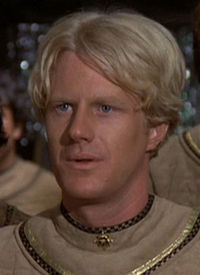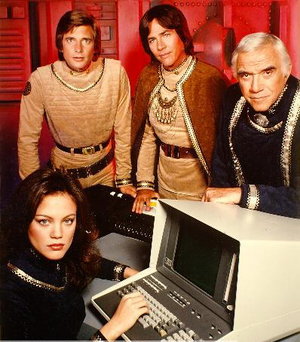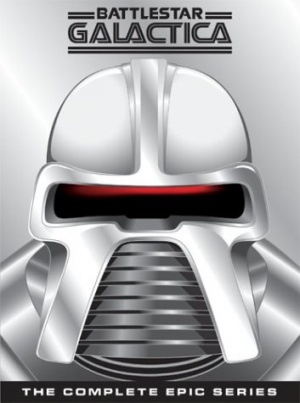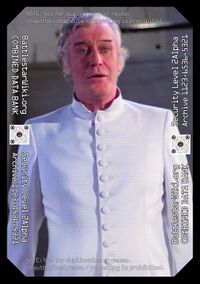|
|
|
|

|
This article or section has been marked for cleanup and revision.
Should there be a need to discuss the merits of the claim, discuss them on the talk page.
|
|
|
|
|
|
|
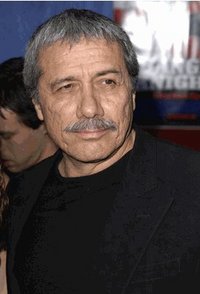
|
| {{{credit}}}
|
| Portrays:
|
William Adama
|
| Date of Birth:
|
February 24, 1947
|
| Date of Death:
|
Missing required parameter 1=month! ,
|
| Age:
|
77
|
| Nationality:
|
 USA USA
|
|
|
@ BW Media
|
[{{{site}}} Official Site]
|
|
|
Edward James Olmos was born February 24, 1947, in East Los Angeles, Calif., and raised in the Boyle Heights neighbourhood. He played baseball as a way to avoid street gangs and drugs, and became the Golden State batting champion. Turning to rock music in his teens, he became lead singer in a band he named Pacific Ocean (because it was "the biggest thing on the West Coast"), which released a record in 1968. Around this time he was attending East Los Angeles College and California State University, performing in clubs, and studying acting. His son Bodie Olmos portrays Brendan "Hot Dog" Costanza.
Biographical Notes[edit]
He married Kaija Keel, daughter of actor Howard Keel, in 1971, having two sons with her: Mico and Bodie. At this time, he started working as an actor in theater and television (in which he appeared in such iconic television series as Hawaii Five-O, Canon, Police Woman, Kojak, and Starsky and Hutch) for a number of years until his mesmerizing performance in the dramatic musical Zoot Suit (1978) led to a Tony Award nomination, a Los Angeles Drama Circle Award and a Theatre World award.
As a result of this recognition, he recreated the role for the film of the musical, thus kick-starting his film career; later that year he starred in Wolfen. This success was quickly followed-up with the acclaimed historical drama The Ballad of Gregorio Cortez and Ridley Scott's landmark Blade Runner.
Following this, he took on the role of Lt. Martin Castillo in the 1980's hit TV series Miami Vice. During his 5-year tenure on the series, the role earned Olmos an Emmy Award and a Golden Globe Award, plus an additional nomination each.
In 1989 Olmos received an Academy Award nomination for his portrayal of Jaime Escalante, the dedicated, real-life math teacher of Stand and Deliver, and in 1992 he made his directorial debut with the powerful feature film American Me, in which he also starred. In that year he also divorced his first wife, Kaija Keel, after 21 years of marriage.
He was honored with a Golden Globe Award and an Emmy Award nomination for his work in the 1994 HBO production The Burning Season, the story of Brazilian political activist Chico Mendes. Olmos also played Jose Menendez in the CBS miniseries Menendez: A Murder in Beverly Hills that year, and was the executive producer of the award-winning NBC documentary Lives in Hazard. In 1994 he also re-married to actress Lorraine Bracco. This marriage was also to end in divorce in 2002, after a 5-year separation.
In 1995 Olmos starred with Jimmy Smits and Esai Morales in the landmark Latino-American drama My Family / Mi Familia, directed by acclaimed filmmaker Gregory Nava. Olmos starred in the ABC miniseries Dead Man's Walk, the prequel to Lonesome Dove, and played Abraham Quintanilla, the strong, supportive father of singing star Selena in the hit biographical drama Selena. Olmos physically transformed himself for the role, gaining 60 pounds.
Olmos' recent work includes appearing in 2 segments of the critically-acclaimed television drama series The West Wing, in which he played Supreme Court hopeful Judge Roberto Mendoza. He also took the title role of the 2002 NBC miniseries Steve Martini's The Judge, for which he earned an Outstanding Actor nomination from the American Latino Media Arts Awards; the PBS series American Family, created by Gregory Nava; the Showtime telefilms Bonanno: A Godfather's Story, The Princess and the Barrio Boy, and In the Time of the Butterflies, with Salma Hayek, in which he played Dominican Republic dictator Rafael Trujillo. He provided the voice of the wise Pre-Columbian village chief in DreamWorks' animated The Road to El Dorado. Among his many other films are Triumph of the Spirit, Talent for the Game, Caught and The Wonderful Ice Cream Suit, based on a Ray Bradbury story.
He has hosted or narrated documentaries including Zapatista, The Unfinished Journey (directed by Steven Spielberg), Good Cop, Bad Kid and Father, Son: America's Desperate Passage.
Other endeavors[edit]
The Americanos Project, produced in conjunction with the Smithsonian Institution as a national museum tour, a feature documentary on HBO, a book of photographs and text about the Latino community across America, a CD, and a concert extravaganza; and the 2002 Los Angeles Latino International Film Festival, co-produced by Olmos and featuring the work of more than 100 Latino filmmakers representing 13 countries.
In 2006, Olmos served as Director for made for television feature film Walkout, based upon the true story of a Mexican-American student activist who protests the ant-Mexican bias present in the American educational system at the time. Olmos worked with Battlestar Galacticas' Exodus director Félix Enríquez Alcalá on this project, who served as the features co-producer.
Olmos participates in many humanitarian efforts, which include working with the David Rockefeller Foundation in the recruitment of new teachers for U.S. schools. He is the executive director of the Lives in Hazard Educational Project, a national gang-prevention program funded by the U.S. Department of Justice, and a national spokesperson for the Southwest Voter Registration Project, where he helps the Latino community in its pursuit of citizenship and voter registration; the Juvenile Diabetes Foundation; and the AIDS Awareness Foundation. He played an instrumental role in the clean-up efforts after the Los Angeles riots, the 1994 Los Angeles earthquake and Hurricane Andrew in Florida, and Hurricane Mitch in Central America.
For his work portraying Admiral William Adama on Battlestar Galactica, Olmos has been nominated for an ALMA Award. The ALMA Award recognizes positive portrayals of Latinos in television, film, and music.
Olmos was briefly mentioned in the book GIT-R-DONE by Larry the Cable Guy as The Faceless Anouncer.
Olmos currently performs in bilingual commercials for Farmer's Insurance.
In January 2008, Olmos had an asteroid named after him. It is called 5608 Olmos.[1]
In October 2009, Olmos appeared in the CNN documentary series Latino in America. He was featured in a segment focusing on Latino actors and their contributions to American television and cinema and his work on Battlestar served as the highlight of his segment. He was also interviewed program host Soledad O'Brien[2].
Joining Battlestar Galactica[edit]
When Ron Moore and David Eick were casting the roles of Laura Roslin and William Adama, they used Mary McDonnell and Edward James Olmos, respectively, as the template for their "ideal" casting choice, which they didn't think they'd actually get (i.e. "The perfect person for this role would be Olmos, but we'll never get an actor that big"). However, Moore and Eick were shocked when both McDonnell and Olmos agreed to join the show. Thus the character of William Adama was written with Edward James Olmos in mind.
Although Edward James Olmos was always the first choice for the role of William Adama, in the event that the production team could not convince him to join alternative casting choices (actors similar to Olmos) included X-Men 2's Brian Cox, Adaptation's Chris Cooper, Alien's Tom Skerritt, Tombstone's Sam Elliott, and Deadwood's Powers Boothe.[3]
Director credits for "Battlestar Galactica"[edit]
External Links[edit]
References[edit]
